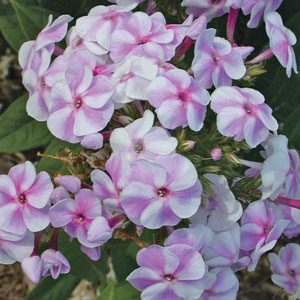5/24/2011
Growing Up Phlox: A Pretty Paniculata
Melanie Neff
 Phlox paniculata
Phlox paniculata (garden or tall phlox) is native to the eastern United States and is considered a backbone in the perennial garden. These long-blooming plants are available in a variety of colors and bring an old-fashioned fragrance to the midsummer garden. They’re popular cut flowers and attractive to butterflies.
Generally taller, herbaceous plants with alternate, simple leaves,
Phlox paniculata often suffer from powdery mildew in the late-summer humidity. However, there are several sturdy, more mildew-resistant varieties currently available on the market, such as the traditional David, as well as newer genetics that include Blushing Shortwood from Blooms of Bressingham.
Propagation and plug culture
Stick cuttings into 72-cell plugs using propagation media with high porosity and water-holding capacity. It should not contain bark or slow-release fertilizer. Maintain 70F (21C) temperature, and use a 500 ppm IBA soluble salts spray within 24 hours of sticking. Once rooting begins, fertilize with a 125 ppm nitrogen fertilizer at least once a week. Watch for chlorosis during propagation.
A broad-spectrum fungicide drench and a fungus gnat larvaecide are recommended within 24 hours of sticking. Begin with a high mist setting for a few days while cuttings adjust from shipment, then use a lower to moderate mist until cuttings begin to root. As soon as there are visible roots that are about 2 to 3 cm, move to a low mist until plants can be weaned off mist completely. Propagation takes approximately 3 to 4 weeks. Pinch liners once out of propagation and grow on for another 4 to 5 weeks.
Vernalization is not required for flowering, but it will decrease time to flower by about 2 weeks and produce a more uniform crop. Vernalize liners at 35F to 45F (1.6C to 7.2C) for at least 5 weeks.
Growing on
Transplant liners into a 1-gal. pot with one cell per pot, in porous soil with good drainage. Maintain a pH of 5.5 to 6.5, and EC of 1.5 to 3 mS/cm.
For best results, provide at least 14 hours of light per day or produce during naturally occurring long days and outdoors for best light levels and flowering uniformity. Plant 72-cell liners in April for saleable flowering pots in about 12 to 14 weeks. This is with one pinch in the final sales container at 4 weeks after transplant. For earlier flowering, improved uniformity and vigor, use vernalized liners. This is based upon outdoor trials performed in Lancaster, Pennsylvania, USDA Hardiness Zone 6. For optimum performance, we recommend at least 5 weeks of vernalization at 35F to 45F (2C to 7C).
Take care not to overwater. This plant does not like to remain wet. While actively growing, plants perform well with a constant liquid feed of 100 to 150 ppm nitrogen. Grow at a minimum night temperature of 60F to 65F (15C to 18C). In our trials, we pinched once at 4 weeks after planting to increase branching. Flowering will be earlier without this pinch. Some taller varieties may benefit from growth regulator applications.
Potential insect problems include thrips and whiteflies. Scouting and early detection is key. Preventative sprays for powdery mildew will be necessary during humid conditions. Keep plants well spaced, maximize airflow, and try to water early in the day to allow sufficient time for foliage to dry going into the evening. All of these practices will help prevent powdery mildew in your crop.
GT
Melanie Neff is a technical support specialist at Green Leaf Plants in Lancaster, Pennsylvania. Using data collected in the Trial Garden at Green Leaf, Melanie and the product support team develop authoritative technical guides for many plants. These are available online at GLplants.com/technical guides.